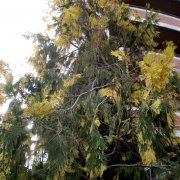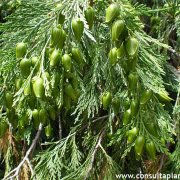Care of the tree Calocedrus decurrens or Incense cedar |
|
The genus Calocedrus, family Cupressaceae, includes 4 species of native trees from East Asia and West North America. The species are: Calocedrus decurrens, Calocedrus rupestris, Calocedrus formosana, Calocedrus macrolepis. Common names: Incense cedar, California incense-cedar. This species is native to California. They are large trees that reach 45 meters (147.6 feet) in height and live for hundreds of years. They have a long, narrow column shape and very dense light green foliage with yellow parts. The leaves appear as small scales. The bark is reddish. The male flowers are globose and shed abundant yellow pollen. The flowers appear in winter and the cones in autumn. California incense-cedar is used for reforestation, to form hedges or as isolated specimens in large and medium gardens. Wood is highly valued in cabinetmaking for its high quality. Calocedrus decurrens needs full sun exposure; they resist frost well. Incense cedar can be grown in any type of soil, even limestone. Irrigation will be moderate throughout the year as they resist drought well. In regions with a Mediterranean climate, it's advisable to water thoroughly during the summer. California incense-cedar tolerates molding pruning, although it is not strictly necessary. Calocedrus decurrens is a tree resistant to pests and diseases. Incense cedar propagates from seeds. |
Images of the tree Calocedrus decurrens or Incense cedar |
Find plants
Calocedrus decurrens or Incense cedar | Care and Growing
© 2025 FavThemes




